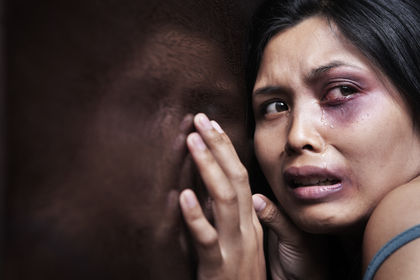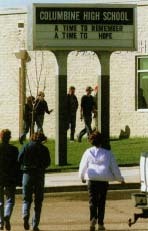Violence

Violence is the use of physical force to injure people or property. Violence may cause physical pain to those who experience it directly, as well as emotional distress to those who either experience or witness it. Individuals, families, schools, workplaces, communities, society, and the environment all are harmed by violence.
KEYWORDS
for searching the Internet and other reference sources
Abuse
Hate crimes
Hatred
Prevention
Self-regulation
Social modeling
What Is Violence?
Violence is a social and health problem for all who experience and witness it. Violence takes many forms, including:
- Family violence, often referred to as domestic abuse, child abuse, child maltreatment, spouse abuse, and wife battering
- Peer group violence, which includes workplace violence, school violence, gang violence, and bullying *
- Sexual violence, which includes rape * , date rape, marital rape, intimate partner abuse, and child sexual abuse
- Abuse of power, which includes mistreatment of children, students, elders, people with disabilities, and others who are smaller or less powerful than the abuser
- Community violence, which includes assaults, fights, shootings, homicides, and most forms of peer violence
- Hate crimes and hate speech, which target victims based on gender, age, race, ethnicity, religious belief, or sexual orientation
- Media violence, shown on television, in film, and in video games.
Why Do People Behave Violently?
Research indicates that violent behavior may have many different causes, some of which are inborn but most of which are learned from experiencing or witnessing violent behavior by others, particularly those who are role models.
* bullying is when a person repeatedly intimidates or acts aggressively toward those with less power or ability to defend themselves.
* rape is when a person forces another person to have sexual intercourse. or engage in other unwanted sexual activities.
Genetics
Chromosomes carry genetic messages from parents to offspring, and there is some research that suggests that, in some cases, aggressiveness may be inherited.
Brain injury
Injury to the front parts of the brain may remove some personal control over anger and aggression.
Antisocial personality disorder
People with antisocial personality disorder often behave violently even as children. They may disregard their own safety and the safety of others. People with this disorder do not seem to understand that violence harms other people, and they do not seem to have a conscience that tells them right from wrong. The terms sociopath and psychopath sometimes are used to describe people with antisocial personality disorder.
Alcohol and substance abuse
Drinking and drugs often play a role in violence. For some, these substaneces interfere with otherwise good judgement or behavior. Some people try to use alcohol or drugs to treat their feelings of anger or depression, but instead feel worse. Violence toward others—or towards themselves—can result.
Desensitization
Constantly viewing violence at home, in communities, or on television can lead people to believe that violence is a normal part of life. People who are surrounded by violence may reach a point where they no longer notice violent events or remember that peaceful behavior is a possibility.
Learned helplessness
People who resign themselves to the belief that violence is an inevitable part of their lives may give up trying to avoid or escape that violence. They may become passive and unable to create safety for themselves or their families. Battered wives who remain at home with battering husbands, for example, may believe that trying to escape violence is hopeless.
Social modeling
Children learn by observation and by imitation. Children who observe their home, school, or media role models behaving in violent ways may come to believe that turning angry feelings into angry actions is acceptable behavior, or even the most effective way to solve problems. Such children may never learn peaceful behaviors or cooperative ways to solve problems.
Parents who model abusive behavior at home can create a cycle of violence, teaching children to grow up to be abusive adults. The importance of positive role models and the dangers of negative role models should not be underestimated.
What Is Wrong with
Media Violence?
Research shows that media violence can lead to real violence in multiple ways. The U.S. Surgeon General and the U.S. National Institute of Mental Health both have reported that watching television violence is an important predictor of aggressive behavior. Children's cartoons and music videos in particular often portray violence. American children see about 16,000 simulated murders and 200,000 acts of violence on television by age 18. In nearly 75 percent of those cases, punishment is not shown to be a consequence of violent behavior.
Perhaps potentially even more serious is the link between violence and some interactive video games. During violent video games, the player identifies with the point of view of the aggressor and practices violent thoughts, feelings, and actions. For some people, with enough reinforcement, violent behaviors can become accessible or even automatic if and when the player later encounters conflict in real life.
Learning the boundaries between anger (emotion) and violence (physical force) is an important developmental task for all people and all cultures. It is possible to have angry feelings without turning those feelings into angry actions or violent behaviors. Expressing anger in a nonviolent way can be healthy. However, parents, adult mentors, media, and community leaders first must model nonviolent conflict-resolution skills for young people to learn them.
How Is Violence Treated and Prevented?
People who experience or witness violence should react immediately. Police and violence hotlines should be called in an emergency. People who have been injured should be taken to a clinic or hospital emergency room for treatment. When an immediate crisis has ended, a family doctor or school counselor or member of the clergy should be contacted for counseling and referrals. Shelters and child protection agencies can help battered women and children. Counseling can help batterers and their families to learn better behaviors for managing stress, conflict, and anger. Therapists can help people with post-traumatic stress disorder * achieve emotional recovery from the aftermath of violence.

Social Modeling
and Self-Regulation
Social psychologist Albert Bandura has been studying social modeling, observational learning, aggression, and self-regulation since the 1970s. Bandura's theories indicate that role models (social modeling) can influence people toward creativity or toward violence. If children observe violent behavior at home, in school, or on television, they may come to believe that turning angry feelings into angry actions is acceptable behavior. When these children become angry themselves, they will display the behaviors they have observed, and they even may create new angry behaviors that go beyond what they have learned from their models.
Another important aspect of Bandura's research focuses on self-direction and self-efficacy, or people's beliefs about their own abilities to influence and affect the world around them. If children observe adults failing to control their own angry feelings or violent behaviors, or if they observe violent behavior going unpunished, they may come to believe that peacefild behaviors cannot succeed or are not worthwhile activities. They may lose their motivation to learn cooperative problem-solving skills, or they may quit before they achieve success in using these skills.
* post-traumatic stress disorder is a mental disorder in which people who have survived a terrifying event relive their terror in nightmares, memories, and feelings of fear. It is severe enough to interfere with everyday living and can occur after a natural disaster, military combat, rape, mugging, or other violence.
Those who commit violent acts or have violent or angry feelings need to receive treatment. Emotional problems, drug and alcohol abuse, and other conditions which make a person more violence-prone need to be dealt with. The social forces that prevent violence—family, friends, and the community—need to take positive steps to make violence less likely and to increase safety.
Physical violence is never an acceptable form of behavior. Everyone has choices. Becoming aware of the problems, deciding not to follow violent patterns, and making a commitment to learn new ways of relating are the keys to change. It is never too late to change the pattern of violence in families, communities, or society.
Resources
Organizations
Nemours Center for Children's Health Media, Alfred I. duPont
Hospital for Children, 1600 Rockland Road, Wilmington, DE 19803. This
organization is dedicated to issues of children's health and
produces the KidsHealth website. Its website has articles about
violence,
http://www.KidsHealth.org
U.S. Centers for Disease Control and Prevention. This government agency
posts fact sheets at its website covering youth violence, domestic
violence, intimate partner violence, and violence in the workplace.
http://www.cdc.gov
Comment about this article, ask questions, or add new information about this topic: